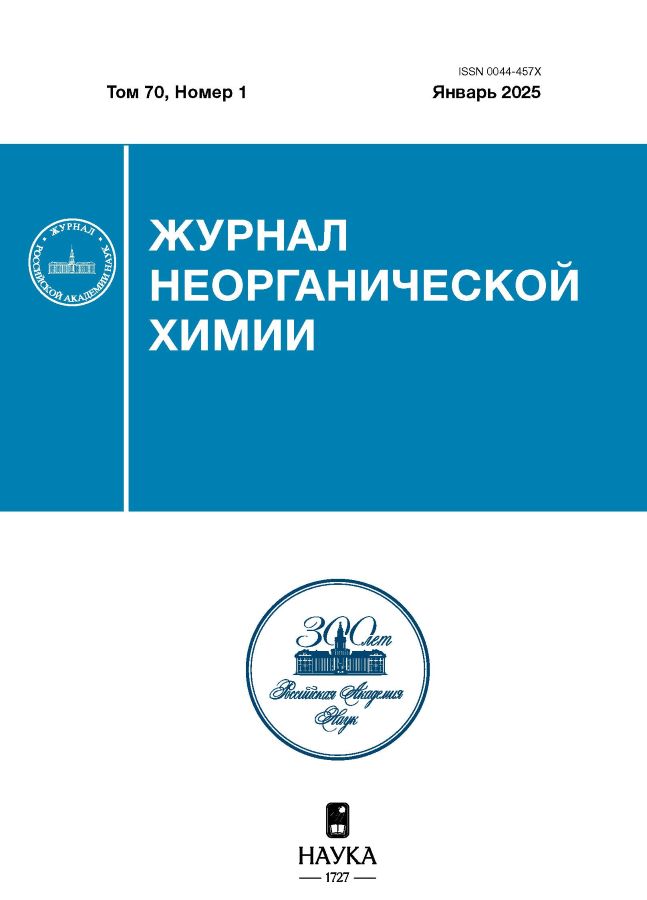Structure of hydrated and sulfated stannous acid. Quantum chemical modeling
- 作者: Zyubina Т.S.1, Zyubin А.S.1, Pisarev R.V.1, Pisareva А.V.1, Dobrovolsky Y.А.1,2
-
隶属关系:
- Federal Research Center of Problems of Chemical Physics RAS
- Center of Hydrogen Energy (PJSFC “Sistema”)
- 期: 卷 70, 编号 1 (2025)
- 页面: 81–90
- 栏目: ТЕОРЕТИЧЕСКАЯ НЕОРГАНИЧЕСКАЯ ХИМИЯ
- URL: https://innoscience.ru/0044-457X/article/view/682192
- DOI: https://doi.org/10.31857/S0044457X25010097
- EDN: https://elibrary.ru/CVIXRH
- ID: 682192
如何引用文章
详细
Different complexes of H2SnO3 and its hydrated and sulfated derivatives were studied by the quantum chemical method within the framework of the cluster approximation with the ωB97XD functional and LanL2DZ(Sn), 6-31G**(O,S,H) basis sets, and with periodic boundary conditions approach with the PBE functional and the basis of the projector-augmented plane waves. It was found that among the hydrated forms, the smallest clusters with features of a SnO2 crystal (twofold and threefold coordinated oxygen atoms and fivefold and sixfold coordinated tin atoms) are (H2SnO3)6 clusters with a diameter of the described sphere d ~ 10 Å.Their combination (in the form of globules (d ~ 20 Å), chains, films) due to hydrogen bonds with each other and water molecules is energetically favorable. It is also possible their consolidation due to covalent Sn–O–Sn and Sn–OH–Sn bonds with the formation of various larger nanoparticles, for example (H2SnO3)12.The interesting thing is that some of them are hollow structures.Sulfuric acid molecules adsorbed on the surface of (SnO2)n(H2O)m clusters are bound to the surface Sn atoms by SO4 2– anions, and the protons split off in this case complete the conduction channels, forming H3O+ and H5O2 + cations in them in addition to OH-anions and water.
全文:
作者简介
Т. Zyubina
Federal Research Center of Problems of Chemical Physics RAS
编辑信件的主要联系方式.
Email: zyubin@icp.ac.ru
俄罗斯联邦, Chernogolovka, 142432
А. Zyubin
Federal Research Center of Problems of Chemical Physics RAS
Email: zyubin@icp.ac.ru
俄罗斯联邦, Chernogolovka, 142432
R. Pisarev
Federal Research Center of Problems of Chemical Physics RAS
Email: zyubin@icp.ac.ru
俄罗斯联邦, Chernogolovka, 142432
А. Pisareva
Federal Research Center of Problems of Chemical Physics RAS
Email: zyubin@icp.ac.ru
俄罗斯联邦, Chernogolovka, 142432
Yu. Dobrovolsky
Federal Research Center of Problems of Chemical Physics RAS; Center of Hydrogen Energy (PJSFC “Sistema”)
Email: zyubin@icp.ac.ru
俄罗斯联邦, Chernogolovka, 142432; Chernogolovka, 142432
参考
- Hattori T., Athoh S., Tagawa T. et al. // Preparation of Catalysts IV. Amsterdam: Elsevier, 1987. p. 113. https://shop.elsevier.com/books/preparation-of-catalysts-iv/poncelet/978-0-444-42796-0
- Печенюк С.И. // Изв. АН. Сер. Хим. 1999. Т. 48. С. 228.
- Kesava М., Dinakaran K. // J. Phys. Chem. C. 2021. V. 125. Р. 130. https://dx.doi.org/10.1021/acs.jpcc.0c08739
- Scipioni R., Gazzoli D., Teocoli F. et al. // Membranes. 2014. V. 4. P. 123. https://www.mdpi.com/2077-0375/4/1/123
- Chen F., Mecheri B., D’Epifanio A. et al. // Fuel Cells. 2010. V. 10. № 5. P. 790. https://onlinelibrary.wiley.com/doi/abs/10.1002/fuce.200900179
- Brutti S., Scipioni R., Navarra M.A. et al. // Int. J. Nanotechnol. 2014. V. 11. P. 882. https://www.inderscienceonline.com/doi/abs/10.1504/IJNT.2014.063796
- Фабричный П.Б., Бабешкин А.М., Портяной В.А. и др. // Журн. структур. химии. 1970. № 4. С. 772.
- Fabrichnyi P.B., Babeshkin A.M., Portyanoi V.A. et al. // J. Struct. Chem. 1971. V. 11. P. 715. https://link.springer.com/article/10.1007/BF00743453
- Fabrichnyi P.B., Babeshkin A.M., Nesmeyanov A.N. // J. Phys. Chem. Solids. 1970. V. 31. P. 1399. https://www.sciencedirect.com/science/article/abs/pii/0022369770901447
- Willstuter R., Krant H., Fremery R. // Ber. 1924. Bd. 57. S. 1491.
- Денисова Е.Ф., Плетнев Р.Н., Федотов М.А. и др. Радиоспектроскопия твердого тела. Свердловск: УНЦ АН СССР, 1984. С. 54.
- FabritchnyiP., AfanassovM., DemazeauG. // C.R. Acad. Sc. Paris. 1986. V. 303. Ser. II. P. 1197.
- Кострыкин А.В., Спиридонов Ф.М., Линько И.В. и др. // Журн. структур. химии. 2007. Т. 52. С. 1176.
- Giesekke E.W., Gutowsky H.S., Kirkov P. et al. // Inorg. Chem. 1967. V. 6. P. 1294. https://pubs.acs.org/doi/10.1021/ic50053a005
- Паршуткин В.В., Ярославцев А.Б., Прозоровская З.Н. и др. // Журн. неорган. химии. 1985. Т. 30. № 1. C. 56.
- Brauer G. Handbook der Preparativen Anorganischen Chemie in drei Banden. Stuttgart: Ferdinand Enke Verlag, 1975.
- Karelin A.I., Leonova L.S., Tkacheva N.S. et al. // Heliyon. 2022. V. 8. P. e11450. https://doi.org/10.1016/j.heliyon.2022.e11450
- Liu L., Pu Y., Lu Y. et al. // J. Membr. Sci. 2021. V. 621. P. 118972. https://doi.org/10.1016/j.memsci.2020.118972
- Navarra M.A., Abbati C., Scrosati B. // J. Power Sources. 2008. V. 183. P. 109. https://doi.org/10.1016/j.jpowsour.2008.04.033
- Arata K. // Green Chem. 2009. V. 11. P. 1719. https://doi.org/10.1039/B822795K
- Varala R., Narayana V., Kulakarni S.R. et al. // Arab. J. Chem. 2016. V. 9. P. 550. https://www.sciencedirect.com/science/article/pii/S1878535216300028
- Chai J.-D., Head-Gordon M. // J. Chem. Phys. 2008. V. 128. P. 084106. https://doi.org/10.1063/1.2834918
- Krishnan R., Binkley J.S., Seeger R. et al. // J. Chem. Phys. 1980. V. 72. P. 650. https://doi.org/10.1063/1.438955
- Johnson B.J., Gill P.M.W., Pople J.A. // J. Chem. Phys. 1993. V.98. P. 5612. https://doi.org/10.1063/1.464906
- Wadt W.R., Hay P.J. // J. Chem. Phys. 1985. V. 82. P. 284. https://doi.org/10.1063/1.448800
- Frisch M.J., Trucks G.W., Schlegel H.B. et al. Gaussian 09, Revision B.01, Gaussian, Inc., Wallingford CT, 2010.
- Perdew J.P., Burke K., Ernzerhof M. // Phys. Rev. Lett. 1996. V. 77. P. 3865. https://doi.org/10.1103/PhysRevLett.77.3865
- Hafner J. // J. Comput. Chem. 2008. V.29. P. 2044. https://doi.org/10.1002/jcc.21057
- Kresse G., Hafner J. // Phys. Rev. B. 1993. V. 47. P. 558. https://doi.org/10.1103/PhysRevB.47.558
- Kresse G., Hafner J. // Phys. Rev. B. 1994. V. 49. P. 14251.
- Kresse G., Furthmuller J. // Phys. Rev. B. 1996. V. 54. P. 11169. https://doi.org/10.1103/physrevb.54.11169
- Kresse G., Joubert D. // Phys. Rev. B. 1999. V. 59. P. 1758. https://doi.org/10.1103/physrevb.59.1758
- Хьюи Дж. Неорганическая химия. М.: Химия, 1987. 695 с.
- Страумал Е.А., Юркова Л.Л., Баранчиков А.Е. и др. // Журн. неорган. химии. 2021. Т. 66. С. 298.
- Лермонтов С.А., Юркова Л.Л., Страумал Е.А. и др. // Журн. неорган. химии. 2018. Т. 63. С. 283.
- Карелин А.И., Ткачева Н.С., Надхина С.Е. и др. // Журн. неорган. химии. 2016. Т. 61. С. 1201.
- Карелин А.И., Леонова Л.С., Арсатов А.В. и др. // Журн. неорган. химии. 2013. Т. 58. С. 804.
补充文件












